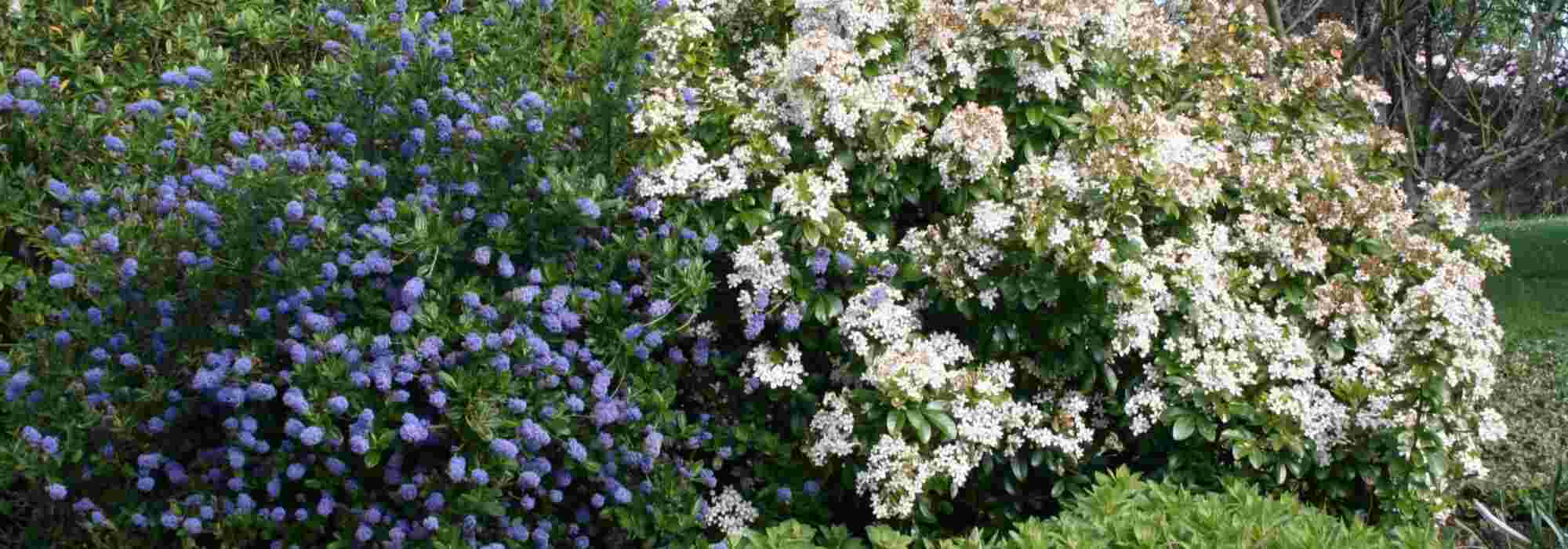
Ceanothus: 5 ideas for successful combinations
As a hedge or in a border
Contents
Ceanothus or California lilac is a beautiful bush that produces in spring or summer, depending on whether it is evergreen or deciduous, flowering in the form of generous fragrant spikes reminiscent of lilacs. Its flowers, most often an astonishing blue, sometimes pink or white, stand above very decorative foliage allowing all kinds of combinations.
Its somewhat wild habit brings a touch of freshness and cheer to all naturalistic gardens, romantic gardens, seaside settings, or even city gardens. It is indispensable in a flowering hedge, as a specimen but also as groundcover in a rockery or in a container on the terrace, for the smaller varieties.
Discover our 5 best ideas for combinations around the Ceanothus, with all sorts of bushes or perennial plants, to compose colourful and contrasting scenes or remarkable shades of blue.
As a multicoloured flowering hedge
Evergreen ceanothuses of medium stature such as Ceanothus impressus ‘Victoria’ or Ceanothe arboreus ‘Trewithen Blue’ make a wonderful addition to lively, flowering hedges where they allow their fragrant flowers to open in spring alongside other flowering bushes. With fast growth, they form very floriferous, bushy masses.
As they become rather inconspicuous after flowering, best to choose companions with staggered flowering or decorative foliage, deciduous or evergreen (Pittosporum, Nandina, Elaeagnus ebbingei…) and to associate them with bushes that will precede or follow their flowering: Viburnum rhytidophyllum (from January), Cornus mas (in flower from February), Forsythias, syringas vulgaris with clusters of small blue, white or pink flowers (April–May), glaucous coronillas, shrubby cistus (May–June), Buddlejas, Weigela florida, shrub roses or lavateras in summer.

An example of a hedge planting: Cornus mas Jolico, Forsythia such as Spectabilis for example, Ceanothus impressus Victoria, Syringa persica and Buddleja Nanho Blue
The slightly untidy habit of ceanothuses provides a contrast of shape with the formality of hedge conifers such as yews, thujas or junipers.
In a scented hedge, they pair perfectly with mock orange Philadelphus coronarius or Mexican orange.
Refreshing white-and-blue ambience
Ceanothus offer some of garden’s most beautiful blue flowers! Deep blue of Ceanothus ‘Skylark’, dark blue of Ceanothus ‘Concha’, sky blue of Ceanothus pallidus ‘Marie Blue’. Pair them with other flowering bushes and beautiful perennials in full sun to create an azure-themed border, such as Caryopteris, lavateras, Perovskia, delphiniums, lavenders, nepetas, Knautia arvensis, Echinops, Salvia nemorosa ‘April Night’, Austrian veronicas, Madeiran viper’s-bugloss, or Lupinus ‘The Governor’.
Dot with a few clumps of white flowers, for example with Phlox paniculata, Dianthus plumarius, gauras, the spikes of Melica ciliata or a silver sage and Papaver orientale ‘Perry’s White’. These fresh combinations suit coastal gardens very well, where ceanothus acclimatise easily.
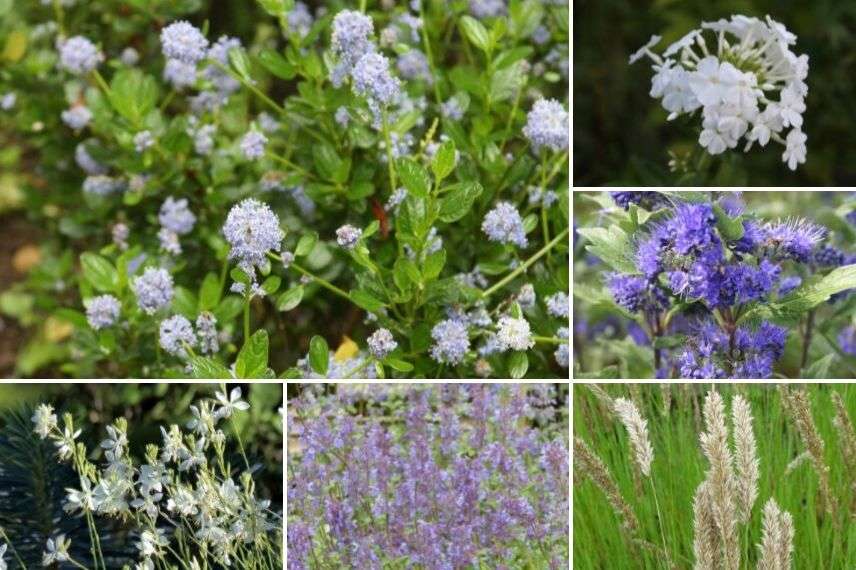
Blue-and-white planting idea: Ceanothus ‘Skylark’, Phlox paniculata ‘Fujiyama’, Caryopteris x clandonensis ‘Heavenly Blue’, Melica ciliata, Nepeta ‘Six Hills Giant’ and Gaura lindheimeri ‘Snowbird’
Ceanothus with blue flowering offer a lovely contrast of shades with yellow-flowering perennials such as achilleas, Verbascum olympicum (Mullein of Olympus), goldenrods and yellow-flowering bushes such as brooms and shrubby potentillas that bloom at same time as summer ceanothus.
Discover other Ceanothus
View all →Available in 1 sizes
Available in 0 sizes
Available in 1 sizes
Available in 3 sizes
Available in 3 sizes
Available in 0 sizes
Available in 1 sizes
Available in 1 sizes
Available in 2 sizes
Available in 1 sizes
In a pink, romantic scene
Summer ceanothus such as Ceanothus pallidus ‘Marie Rose®’ and ‘Marie Simon’, with their powder-pink flowers, will unfold into a delicate cloud in large, lush, romantic displays. Paired with butterfly bushes in bright summer-pink flowering (Buddleia davidii ‘Pink Delight’), with Caryopteris (x) clandonensis ‘Pink Perfection’, they will form magnificent backdrops for shrub roses, cotinus and a Lagerstroemia indica from the ‘Summer Beauty®’ series.
Their delicate spikes will emerge from a hummock of hydrangeas and a perennial compound made up of large Thalictrums, Alcea rosea, Campanula ‘Ringsabell Mulberry Rose’, salvias, and giant asters.
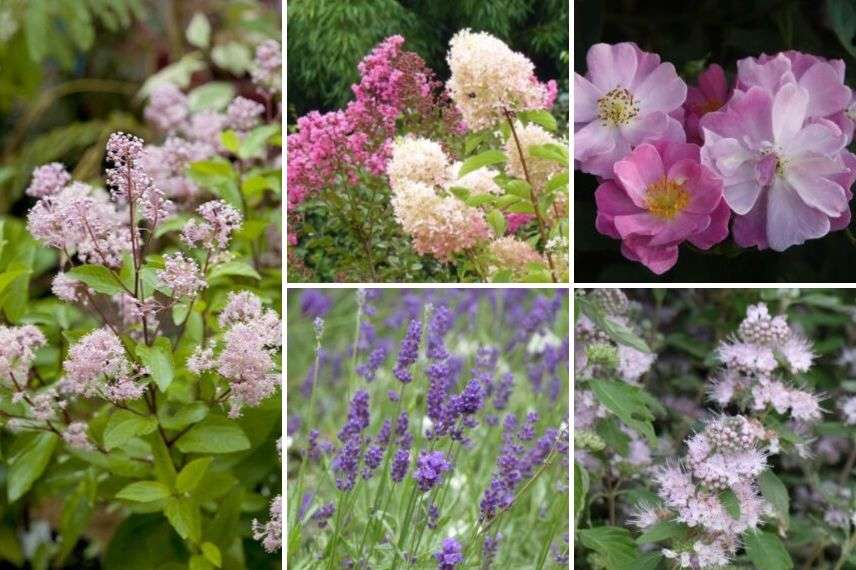
A romantic planting idea: Ceanothus Marie Rose, Lagerstroemia indica and Hydrangea paniculata Vanille Fraise, Rose Lavender Dream, Lavender Hidcote and Caryopteris Pink Perfection
A burst of roses punctate with Dianthus plumarius, Achillées milleflolium, Agastaches, a bed of groundcover roses or g auras that will clothe their base and accompany their flowering.
A few clumps of Artemisias and Stachys byzantina will soften this pink symphony while some purple-leaved heucheras will accentuate it.
To fill out a natural-looking border
Ceanothus with their generous, unbridled flowering and bushy growth work wonders in naturalistic gardens to create lush, abundant scenes. They always bring scale, colour and plenty of charm to shrub or perennial borders.
In the background of a naturalistic border, modest-sized ceanothus (Ceanothus ‘Skylark’, ‘Gloire de Versailles’) make a big impact when mixed with Buddleias, alongside which they form beautiful, very floriferous bushes surrounded by summer-flowering perennials such as thistles (Echinops ritro, Eryngium planum), oriental poppies, echinaceas, Nigella damascena, autumn asters, Verbena bonariensis.
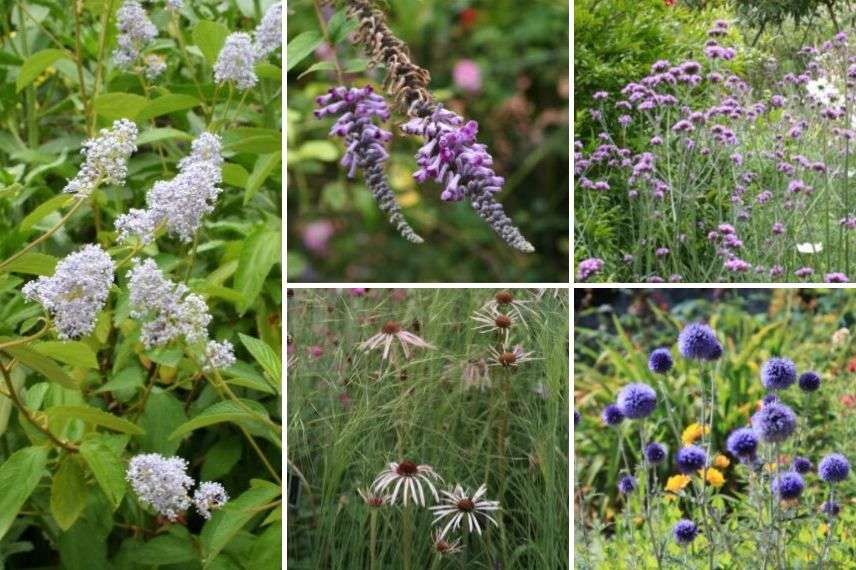
An idea for a natural pairing: Ceanothus Gloire de Versailles, Buddleja lindleyana, Verbena bonariensis, Echinacea pallida et Stipa capillata, Echinops ritro
For lightness, you can incorporate into your border some grasses such as pennisetum whose graceful habit contrasts with their dense, tufted silhouette but also with many other grasses (Stipa, Carex comans, Eragrostis…).
To add volume and colour to a rockery
Creeping varieties such as Ceanothus griseus var. horizontalis ‘Yankee Point‘ and the Ceanothus prostratus are perfect for covering rockeries or large slopes with abundant flowers in spring.
They can be paired with other ground-cover bushes such as Rosmarinus officinalis Prostratus, creeping brooms and creeping junipers, cistus, ground-cover roses, shrubby potentillas or Teucrium lucidrys. They can also be planted with creeping perennials for dry soil such as blue aubrieta, Ceratostigma plumbaginoides or creeping Plumbago, sedums and Dianthus deltoides.
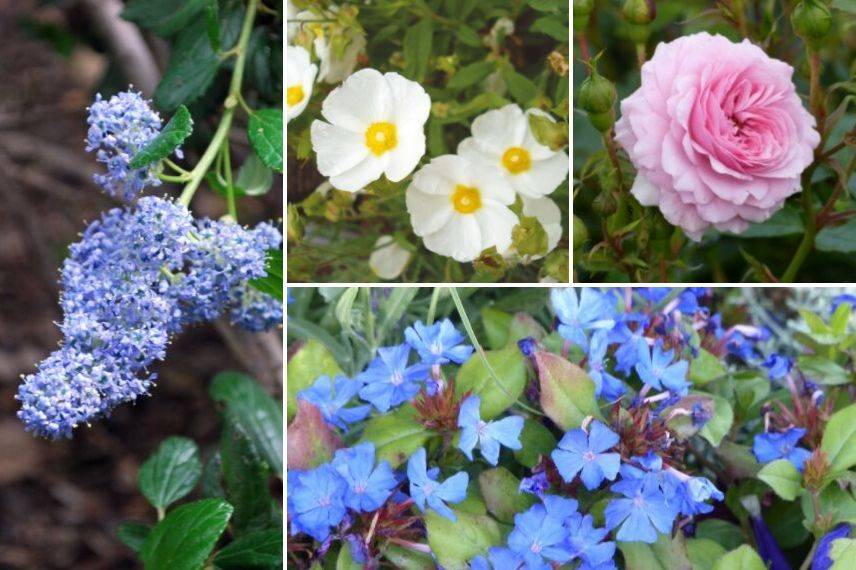
An idea for planting on a slope: Ceanothus griseus var. horizontalis Yankee Point, Cistus monspeliensis in mild climate (or otherwise Potentilla), rose Larissa and Ceratostigma plumbaginoides
- Subscribe!
- Contents
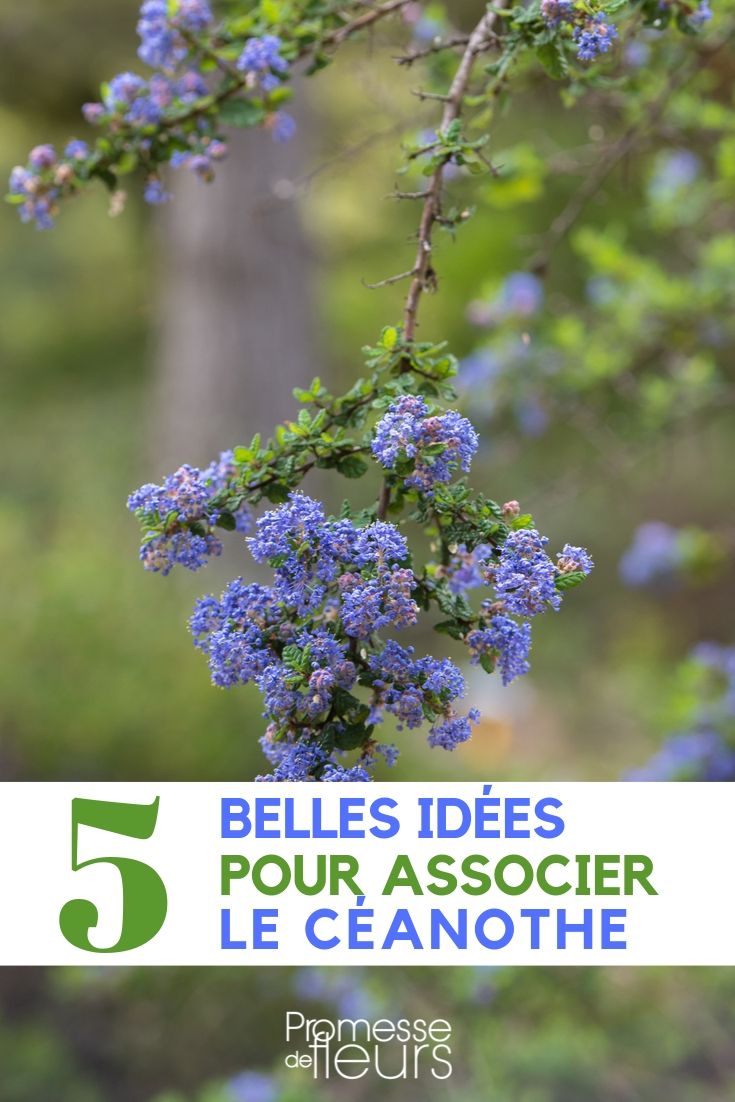































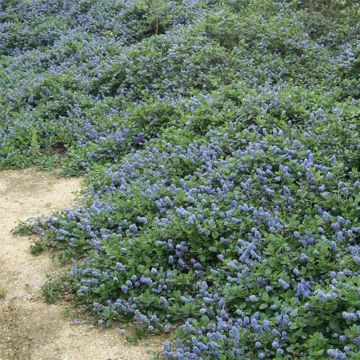
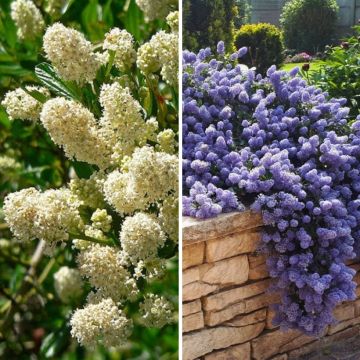
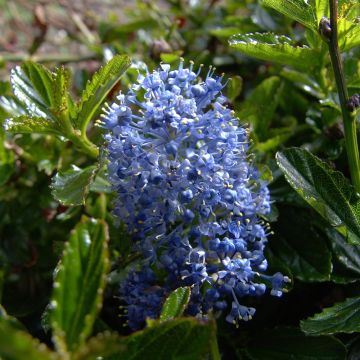
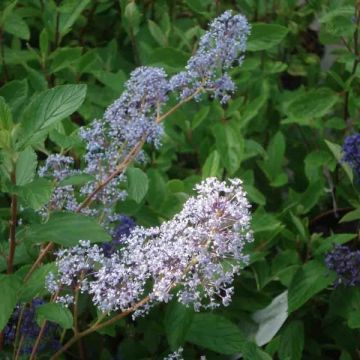
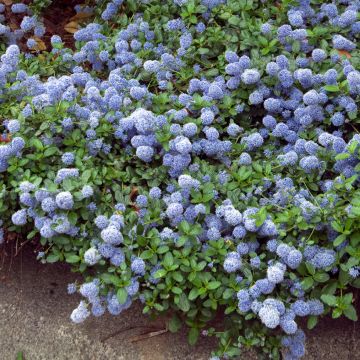
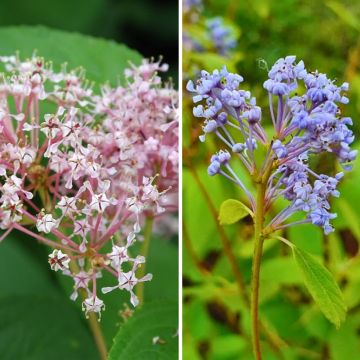

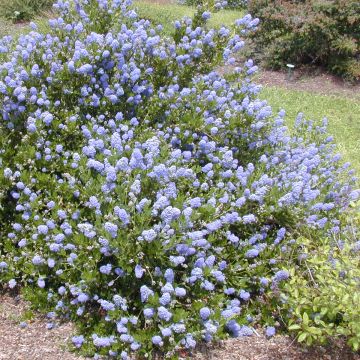
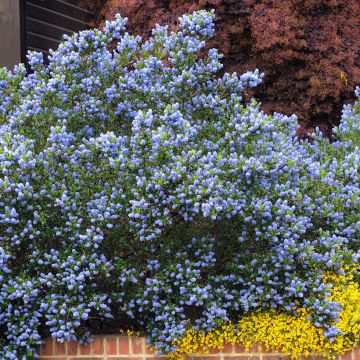

Comments